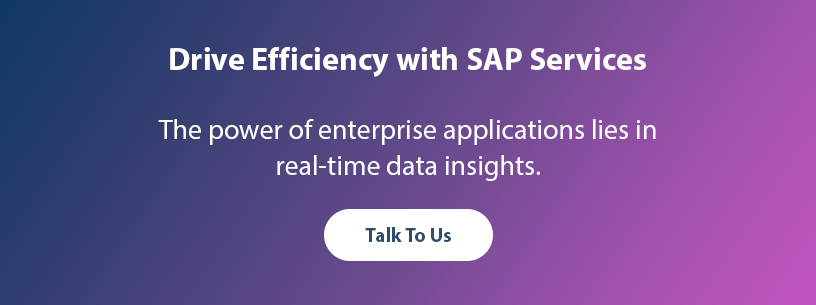What is new asset accounting?
Asset accounting in SAP S/4HANA is the new method to manage and supervise fixed assets in the SAP system. It helps in providing detailed information on the transaction. It is a subsidiary of the general ledgers.
How is it different from the previous version?
Traditional asset accounting does not require assigning every depreciation area to a ledger group. However, each depreciation area must be assigned to a ledger group in the new Asset Accounting. This is a mandatory step in new asset accounting.
Features
All the depreciation areas can post in real-time
This allows for quick visibility into any breakdowns that occur. It also provides the opportunity to troubleshoot and fix any problems quickly. This reduces downtime and ensures that operations run smoothly.
Accounting principle assignment in the depreciation area
There is also an option of assigning Accounting Principles to the depreciation area. This has to be consistent with the General Ledger Account if you want to use depreciation area 01 for your leading ledger. Then whatever the Accounting Principle you assign to the leading ledger, the same one must also be given to the depreciation area.
To check which accounting principle is assigned to the leading ledger, you can see the Accounting Principle in the depreciation area only when you have assigned it to the ledger group.
FAA_CMP/AJAB for year-end closing
In S/4HANA, there is T-Code FAA_CMP along with AJAB to close the Fiscal year for Asset Accounting.
Currencies in asset accounting in SAP
Companies must often draw up a set of statutory accounts in their local country. However, they must adjust those statutory accounts when reporting to the head office. This is because they require consistency in a report to group practices. And likewise, they need to adjust for local GAAP or report in different currencies.
Although in SAP S/4 HANA, up to 10 currencies are now available. Of these 10, 2 are fixed, and eight are freely definable. Only three currencies can be used in Asset Accounting.
Ledgers in asset accounting in SAP
Earlier, if you wanted to record and report on data for more than one accounting principle in SAP, the only way to do this was by using a different area of the chart of accounts.
The new SAP General Ledger brought in the technology for parallel ledgers. This enables you to keep two sets of books simultaneously.
However, not all companies may want to set up parallel ledgers. Especially if they only have a few differences between accounting principles. Therefore, New Asset Accounting in SAP with S/4 HANA still allows the choice of the two methods. These are: – Account Approach and Ledger Approach.
Types of depreciation in SAP S/4HANA
S/4 HANA provides different types of depreciation (i.e., Planned and Unplanned). For example, ordinary or planned depreciation is routine depreciation based on the criteria in the asset master record.
Transaction AFAB
S/4 HANA still uses Transaction Code T-Code AFAB, but the selection screen differs slightly.
You no longer need to choose a reason for the posting run. SAP S/4 HANA will automatically know whether it’s planned, restart or unplanned depreciation.
You can choose to run the posting separately for each accounting principle. Else you can leave the Accounting Principle field blank and run for all accounting principles.
Although the depreciation transaction runs in the background in New Asset Accounting, it still runs faster. This is because it needs to recalculate every asset. Instead, it just takes the planned values that are always current.
Info for posting parameters
A beneficial addition is the “Info for Posting Parameters” button at the top of the Depreciation Posting Run selection. This lets you see which periods and accounting principles were last posted.
Simplified AFAB screen in SAP asset accounting
Now SAP has simplified the AFAB screen. Because when previously we had to re-run the depreciation in a particular period, we always had to think for a minute about which button to choose and how the system figured it out automatically.
New control account for asset accounting in S/4 HANA that is a technical clearing account
Depreciation calculation in S/4HANA (as part of SAP asset accounting)
SAP new asset accounting brings with it the new Depreciation Calculation Engine. It is designed with more country-specific requirements and calculates by period intervals rather than the transaction.
The engine also includes more flexibility for time-dependent changes. For example, while making mid-year changes to depreciation, we use the concepts of useful life, depreciation key, scrap value, etc.
Benefits
ASKB and need of delta depreciation step eliminated
This has led to increased efficiency in the production process. It has also helped reduce costs, allowing businesses to maximize their profits. Furthermore, it has enabled them to deliver products and services faster and at a higher quality.
Elimination of the t-code AJRW for “carry forward the asset balances to the next fiscal year”
We performed two T-Codes for GL Closing FAGLGVTR and Asset Closing AJRW earlier in ECC.
Now, in S/4HANA, the T-Code AJRW is eliminated, and we can carry forward the Asset Balances by using the T-Code FAGLGVTR only.
In S/4HANA, by using FAGLGVTR, you can undo or retake back Asset/GL Balances, we have a reset option here or, after forwarding the balance, if you have made one entry in the previous year. You need not reset it; you need to execute it for that year again so that it will carry forward that remaining amount only in the next fiscal year.
Instance access to correct up-to-date values
Now you can post all the depreciation areas in New Asset Accounting equally in real-time. You can also navigate and drill down to most financial documents in Asset Explorer (AWO1N T-code), not just those in the main depreciation area.
When we change an asset, the system immediately updates its planned depreciation (used to post actual depreciation), and all reports show the up-to-date values.
Single source of truth with SAP Asset Accounting
The reconciliation between FI and Asset Accounting is assured by design. For example, we can now use the reconciliation accounts in all depreciation areas, which helps preserve the integrity of the postings.
On a general note, the reconciliation accounts don’t allow manual postings.
Further, the cost elements are now integrated into the chart of account master records. This integration helps to ensure that SAP ERP Controlling (CO) is aligned with SAP FI.
Postings to the other ledgers no longer occur separately at the period-end postings. Hence, you would not omit the postings accidentally. Additionally, you have access to up-to-date figures all through the period, not just at the month-end.
Simplification of posting logic
In S/4HANA, SAP has introduced new transactions and accounts that allow you to post independently to individual depreciation areas, accounting principles, or ledger groups if required.
Transparency
You can produce a separate line item for each asset posting, including the acquisition and retirement values, the depreciation P/L charge, and the accumulated depreciation. This whole allows full visibility in SAP FI.
No redundancy of data
New Asset Accounting no longer requires delta depreciation and normal depreciation areas. (Elimination of ASKB T-code)
New logic and easier data structures support reporting
Now you rarely need the Custom reports to merge data from different places or tables. This is because now the system stores more data from CO, Profitability Analysis ( PA), purchasing, Sales and Distribution ( SD), Asset Accounting, and so on in a single table in FI. It is also available in the general ledger line item reports. (ACDOCA Table)
Smart migration
When migrating from another SAP system to SAP S/4 HANA, compatibility views in SAP S/4 HANA have the same name as the previous tables to allow custom reports and certain programs to continue to run.
If your existing system has been converted to SAP S/4 HANA, data from Years before the migration are stored and remain accessible for reporting.
You can choose which depreciation area posts to which ledger (previously only Depreciation Area 1) is posted to the leading ledger.
Smooth period-end
The period-end procedure is simpler and faster, with up-to-date data available all throughout the month. You can either do Postings directly or in the background. Thus, there are no more batch postings.
The depreciation posting at the month-end is faster because the values don’t have to be recalculated. Since you can post the planned value directly, you do not require additional batch postings.
Posting each ledger to different periods is possible if the year start, and end dates are the same.
Faster calculation
Although the depreciation transaction is still run in the background in New Asset Accounting, it will run faster as it’s not recalculating every asset and just taking the planned values that are always up to date. As before, you can see all the details in test mode.
Up-to-date depreciation calculation
The system updates the planned depreciation every time we post an asset transaction or make a change. Therefore, asset explorer and asset reports will always show you up-to-date values.
When you run the depreciation transaction at the end of the month, it should be quicker as it simply posts the already calculated planned values. The system still assigns collective documents for depreciation. It doesn’t post one copy for each asset but publishes a separate line item in the general ledger for each purchase. Thus, giving you more detail than before for reporting in Finance.
Flexible depreciation runs
The second point is that you can still run the depreciation for all accounting principles at the same time, or you choose to run it for the different accounting principles separately.
Conclusion
In conclusion, the new Asset Accounting in SAP S/4HANA brings a range of advancements that enhance efficiency, accuracy, and transparency in managing fixed assets. With real-time posting, simplified processes, and up-to-date values, businesses can make informed decisions and optimize their financial operations. Eliminating redundant steps, improved reconciliation, and flexible reporting capabilities further contribute to a streamlined and reliable asset accounting experience. SAP S/4HANA’s new Asset Accounting empowers organizations to effectively track, analyze, and manage their assets for increased profitability and operational success.












